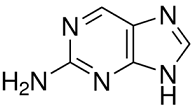All AbMole products are for research use only, cannot be used for human consumption.

2-Aminopurine, a fluorescent analog of guanosine and adenosine, is a widely used fluorescence-decay-based probe of DNA structure. 2-Aminopurine has been used to probe nucleic acid structure and dynamics. 2-Aminopurine has been used to inhibit eukaryotic initiation factor-2α (eIF2α)-phosphorylation of osteoarthritis (OA) chondrocytes. 2-Aminopurine (2AP) is an analog of guanosine and adenosine, which can base pair with cytosine and thymine. It is used as a fluorescent probe in nucleic acid structure and dynamics. 2-Aminopurine (2-AP) inhibits double-stranded RNA-dependent protein kinase, protein kinase R (PKR).
| Molecular Weight | 135.13 |
| Formula | C5H5N5 |
| CAS Number | 452-06-2 |
| Solubility (25°C) | formic acid:water (1:1 v/v) (50 mg/ml) with heating |
| Storage | 2-8°C, protect from light, sealed |
[1] Pai Peng, et al. Analyst. DNA nanodevices monitored with fluorogenic looped-out 2-aminopurine
| Related Nucleic Acid Staining Products |
|---|
| Cy5 maleimide
Cy5 maleimide is a CY dye. |
| Biotin-aniline
Biotin-aniline is a probe with substantially high reactivity towards RNA and DNA. |
| Methyl Green
Methyl Green is a potent fluorescent dye. Methyl Green is a DNA stains of cells and electrophoretic gels. Methyl Green can be used as a stain for direct measuring of viability by both microscopy and flow cytometry, with peaks at 633 and 677 nm. |
| Cyanine 5 Tyramide
Cyanine 5 Tyramide (Tyramide-Cy5) is a red fluorescent dye, it is used as reporter fluorescent substrate for horseradish peroxidase (HRP)-catalyzed deposition that is signal amplification technique in immunoassay and in situ hybridization of nucleic acids. Ex=645; Em=670 |
| Cyanine 5 Tyramide methyl indole
Cyanine 5 Tyramide (Tyramide-Cy5) methyl indole is a red fluorescent dye. |
All AbMole products are for research use only, cannot be used for human consumption or veterinary use. We do not provide products or services to individuals. Please comply with the intended use and do not use AbMole products for any other purpose.


Products are for research use only. Not for human use. We do not sell to patients.
© Copyright 2010-2024 AbMole BioScience. All Rights Reserved.
